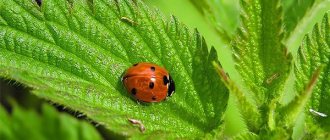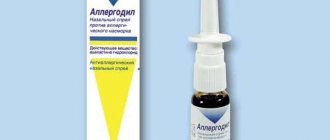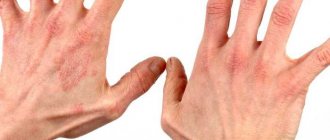Nasal congestion due to allergies: how to eliminate inflammation?
Allergic rhinitis occurs quite often in patients.
The disease is not contagious, but its symptoms are almost the same in all people. Nasal congestion is caused by the action of allergens, which provoke an inflammatory process in the mucous membrane. According to statistics in the Russian Federation, approximately 20% of the total population suffers from nasal congestion due to allergies. The main source of inflammation is the body's immediate reaction to exposure to irritating microparticles. Allergic processes manifest themselves so quickly that sometimes just a few seconds are enough for a person to experience inflammation in the nasal cavity after contact with an allergen.
Allergies can be caused by many triggers:
- Insects (after a bite)
- Pollen from flowering plants (herbs, flowers, trees)
- Mites that live in household dust, beds
- Mold or yeast
- Products
- Medicines
In some patients, allergic rhinitis occurs due to several irritants, in others - only through one type of allergen. In most cases, people who have close relatives suffering from allergies also experience symptoms of the disease.
Infectious causes
If the patient feels that one nostril is breathing poorly, then a rhinoscopic examination should be performed. Diagnostics will allow us to eliminate the mechanical cause of blockage of the nasal canal. The examination reveals tissue hyperemia, ulcers and copious amounts of mucus, which blocks the possibility of inhaling air.
Most infectious diseases affecting the upper respiratory tract are bilateral. But there are a number of diseases that lead to unilateral nasal congestion. In this case, the cause of the pathological condition is pathogenic microflora.
Epipharyngitis
Epipharyngitis is a catarrhal, non-purulent inflammation of the mucous membrane of the nasal canals. The disease manifests itself as damage to the ciliated epithelium. It swells, leading to nasal obstruction. In patients suffering from epipharyngitis, one nostril is constantly clogged. When changing body position, mucus can flow to the opposite part of the nose. This phenomenon indicates that the cavity is clogged with snot, and not with a mechanical barrier.
Symptoms of epipharyngitis:
This respiratory disease is caused by streptococci, meningococci, adenovirus and picornavirus. Symptoms of epipharyngitis are quite subjective. In adults, the temperature may not rise at all, but in newborns it can reach 39 degrees. Inflammation can migrate to the larynx, trachea and bronchi.
Unilateral inflammation of the maxillary sinus
Sinusitis is one of the types of sinusitis, which is characterized by inflammation of the maxillary maxillary sinus. The disease affects the area of bone tissue located on either side of the nose, just below the eyes. Sinusitis affects people of all ages. This is a chronic disease because the bacteria penetrate deep into the small pores of the bone, where they remain viable for years.
Causes and prerequisites for the formation of sinusitis:
Congestion in one nostril is very typical for unilateral sinusitis. The patient develops abundant purulent discharge, headache, especially in the forehead and cheeks, under the eyes. Intoxication develops with high fever.
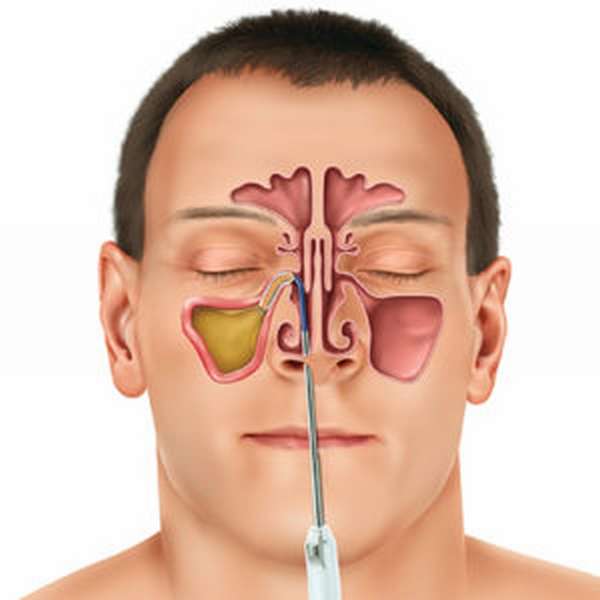
Unilateral sinusitis of the lower sinuses
Chronic rhinitis
The chronic form of catarrhal rhinitis occurs due to poor quality treatment. Microflora penetrates deep into the mucous membrane, causing solid destructive changes in the tissues. The patient's immunity is weakened, and symptoms similar to an allergic reaction appear.
Symptoms of chronic rhinitis:
Crusts form on the inner surfaces of the nasal canals and must be removed. The snot of chronic sluggish rhinitis has a pronounced viscosity. Flow from one nasal cavity to another occurs over a long period of time.
Treatment of pathologies of an infectious nature requires prescription by a doctor after examination of medications and, in some cases, surgical intervention.
How to recognize that nasal congestion is due to allergies?

There are several main symptoms by which nasal congestion of an allergic nature can be distinguished from a viral or bacterial runny nose. Mostly, patients are concerned about the following signs of the disease:
- Paroxysmal sneezing (a person sneezes many times in a row without stopping and regardless of the presence of certain irritating factors)
- Itching in the nose, sometimes burning (this symptom occurs immediately and continues until the end of the allergic reaction)
- Difficulty breathing, worsening at night
- No fever
In addition, by the appearance of the patient, one can understand that he has allergic nasal congestion. For example, usually red spots, swelling, and conjunctivitis form on the patient’s face in the area of the wings of the nose and eyes. Most often, the eyes water, so the capillaries are very pronounced. In most cases, due to itching, patients involuntarily rub the tip of their nose, so it also becomes red and skin irritation becomes noticeable.
Allergic rhinitis begins to appear in childhood, sometimes developing during puberty due to hormonal changes. The intensity of the symptoms determines the degree of allergy:
- Mild (observed in patients who practically do not feel any special changes in the body, symptoms do not affect sleep or activity during the day)
- Medium (classifies allergy symptoms that disrupt sleep and reduce performance)
- Severe (all symptoms are pronounced and occur with great intensity)
If allergic nasal congestion occurs only periodically and is associated with flowering vegetation, then it is called seasonal rhinitis or hay fever. When allergy symptoms appear constantly, then it is year-round.
Typically, patients with allergic rhinitis are very sensitive to strong odors, such as cleaning chemicals, tobacco smoke, perfumes, etc.
Despite the fact that allergy symptoms can be recognized independently, you should still diagnose the body so as not to miss the development of other types of rhinitis. Similar symptoms occur in hormonal, occupational and even atrophic rhinitis. Therefore, it is best to consult an allergist to establish an accurate diagnosis.
Causes of swelling of the nasal mucosa
The main reason for swelling of the nasal passages is the low resistance of the mucous membranes to the harmful effects of certain allergens and elements that cause irritation.
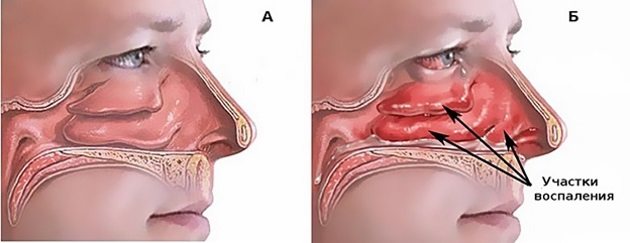
Before putting into practice a specific method of eliminating edema, it is important to determine the exact nature of the allergic reactions.
You can reduce swelling using drug therapy, but in most cases you just need to stop contact with the irritating factor, and the problem will be solved.
Allergic swelling of the nasal mucosa can provoke:
- Infectious lesions of the mucous membranes (viral or bacterial). Prolonged hypothermia sharply reduces a person’s local immunity, which increases the risk of viruses and bacteria entering the body, causing inflammation and swelling of the nasopharynx.
- Mechanical violations of the integrity of the mucous membranes of the nasopharynx most often result in edema.
- Congenital pathologies of the formation of the nasal septum.
- Swelling as a result of hormonal imbalance in the body (most often observed in pregnant women).
Important: only a doctor can diagnose the nature of the development of allergic edema. Based on the results of the tests and tests, the specialist will determine exactly what causes the allergy.
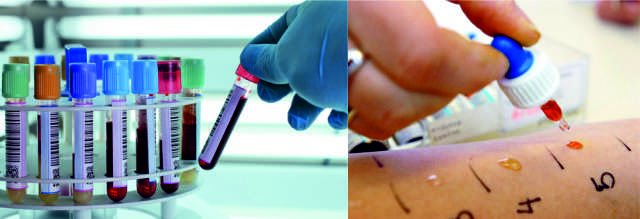
Allergens are the main cause of swelling. There are more than three hundred types of irritants. Most often allergies are caused by:
- plant pollen;
- chemicals used in the fight against insect pests;
- medications;
- dust and mold spores accumulated in residential areas;
- particles of chitin (upper shell) of cockroaches, bedbugs and dust mites;
- pet hair and dead skin particles.
How is allergic rhinitis diagnosed?
Firstly, if signs of a runny nose appear, you need to contact two specialists at once: an ENT specialist and an allergist-immunologist. This is necessary in order to prevent the development of combinations of problems, for example, allergic rhinitis and sinusitis.
To identify allergens, a smear is taken from the nasal cavity for eosinophils. Blood is also taken to determine IgE-specific. But this examination method does not always show accurate results and its cost is quite high.
A more informative diagnostic method is skin testing. To carry it out, scratches are made on the patient's skin and various allergens are applied to microscopic wounds. After 30 minutes, you can determine which stimulus the body reacts negatively to. Skin tests are not performed during pregnancy or during an exacerbation of the disease. In order for the diagnostic results to be correct, do not take antiallergic medications for 7 days before the procedure.
If additional examination is required, the ENT may prescribe x-rays of the paranasal cavities and rhinomanometry to assess nasal congestion.
Consequences if left untreated for a month
Prolonged nasal congestion leads to a lack of oxygen, a person develops constant headaches, general health and performance deteriorate, snoring at night and changes in the voice are often present.
If the congestion is caused by inflammation, then the consequences of nasal congestion can go further, affecting neighboring organs.
Treatment of a runny nose of allergic origin should be prescribed by a specialist. It will take a long time to treat nasal congestion and other manifestations of allergic rhinitis, using a treatment regimen developed by a doctor strictly individually.
Allergy treatment is not only long, but also complex. Modern science is developing more and more new methods to get rid of allergies forever, acting on both the cause of the disease and its pathogenesis. Currently, allergic rhinitis should be treated in several directions simultaneously.
First of all, in order to relieve all allergy symptoms forever, it is necessary to completely eliminate human contact with the allergen. Another radical treatment method is desensitization of the body, that is, changing its response to an antigen. This path may take several years.
More often in therapeutic practice, in the presence of a detailed clinical picture of allergic rhinitis, symptomatic treatment is used. It consists in the use of medications that act on various mechanisms of allergy. These include vasoconstrictors, antihistamines, hormonal, barrier drugs and mast cell stabilizing agents.
To reduce swelling of the mucous membrane and get rid of nasal congestion, vasoconstrictor drugs are used. Their choice should remain with the doctor, since the wrong dosage or duration of the course can cause harm. The required drug (Galazolin, Rinorus, Afrin, Tizin) is selected according to the duration of action (short, medium or long) and is used for no more than 5 days in children and 7 days in adults.
Treatment of congestion of allergic origin is impossible without the use of antihistamines. Levocabastine or Allergodil sprays prevent the development of allergies by blocking histamine, binding to cellular receptors instead.
Hormonal drugs also occupy an important place in the treatment regimen. Having an anti-inflammatory and mucosal restorative effect, Nazarel, Nasonex, Flixonase are prescribed in individual courses, strictly under medical supervision.
It is necessary to treat nasal congestion of allergic origin using simultaneously means of different directions. Only complex and long-term therapy will have a lasting positive effect on allergic rhinitis and help to get rid of nasal congestion for a long time.
Non-traditional treatment methods are best used as a complement to basic therapeutic measures. So, what needs to be done to spread out the nose on the right and left sides?
The simplest, but in many cases effective method is nasal massage. First, you should rub the bridge of the nose and wings in a circle until the skin warms up.
Next, you need to perform light tapping movements for 10 minutes. If you do this procedure regularly, you can improve blood flow in the organ, which will help you avoid various problems in the future.
If congestion occurs as a result of a cold, then it is useful to do inhalations. You can treat the symptoms of ARVI with the help of various herbs (plantain, coltsfoot, St. John's wort, chamomile, calendula, oregano, eucalyptus). The plants need to be poured with boiling water, then you should wait until the infusion cools down a little, and cover your head with a towel and inhale the medicinal vapors.
You can also rinse the nasal passages with saline or treat them with sea water-based products (Aquamaris, Marimer).
In addition, when the nose is constantly stuffy on any side, traditional medicine recommends using horseradish, garlic or onions. They can be used together or separately. To do this, you need to grind the plants and then inhale their vapors. But this method has some disadvantages, these include pain in the eyes and an unpleasant odor.
For the normal functioning of the respiratory organs, it is important to maintain a certain level of humidity (about 50%) in the room. To maintain this parameter, you can use a humidifier. If there is no device, a budget method is used - a wet towel, which should be hung on the radiators before going to bed.
If the blockage of the paranasal sinuses is not caused by sinusitis and other sinusitis, then warming can be carried out. To do this, heat the salt in a frying pan, place it in a fabric bag and apply it to the bridge of the nose. You can use hot potatoes boiled in their jackets in a similar way.
It is worth remembering that even seemingly insignificant symptoms, such as a stuffy nose without a runny nose, require timely treatment. Indeed, in its absence, various complications may arise. The most common consequences include:
- snore;
- loss of smell, which in some cases cannot be restored;
- changes occurring in the brain;
- depression and constant fatigue;
- otitis;
- sinusitis;
- headache developing due to oxygen starvation.
Untimely therapy and undertreated congestion leads to complications, chronicity of the process (chronic rhinitis) and damage to other organs.
How dangerous is allergic rhinitis?
Not all patients believe that nasal congestion due to allergies is a serious symptom. But this opinion is erroneous, because without treatment or with the wrong selection of treatment methods for allergic rhinitis, patients can develop dangerous complications:
- Purulent sinusitis (most often the maxillary cavities are affected)
- Otitis
- Conjunctivitis (occurs in 50% of patients)
- Decreased ability to work
- Bronchial asthma
Treatment of allergies should be carried out using effective methods and it is recommended to begin eliminating the symptoms of rhinitis at the initial stage of development of inflammation. In addition, it will be possible to cure an allergic runny nose only if you identify the irritant allergen and limit contact with it as much as possible.
Treatment of allergic rhinitis
Patients with allergies are seen by an allergist-immunologist. Each patient is individually prescribed a comprehensive treatment program. In modern medical practice, doctors use ASIT, that is, allergen-specific immunotherapy. This method allows you to eliminate many symptoms of rhinitis, including bronchial asthma. Treatment makes it possible to increase the period of remission and reduce the number of antihistamines taken. Using ASIT at the initial stage of disease development, it is possible to prevent complications of its course.
During the acute course of an allergic rhinitis, a specialist prescribes safe and fast-acting medications. The most effective is considered to be a new generation drug, which is characterized by low toxicity and the absence of side effects.
If a patient has a moderate or severe allergic rhinitis, he must be prescribed anti-inflammatory therapy. Such drugs include drugs with hormonal components for intranasal administration. They are selected according to the individual characteristics of each patient. As a rule, allergic rhinitis is treated by an ENT specialist. The anti-inflammatory drug quickly relieves nasal congestion and is superior in action to antihistamines.
Allergic reactions of mild and moderate course require the use of antiallergic medications. They are prescribed for oral use. Second- and third-generation drugs are popular in the pharmaceutical market. These include Zodak, Claritin, Zyrtec, Telfast, etc. Treatment lasts approximately 14 days, but the exact duration of therapy must be determined by the doctor.
Antihistamines can have negative effects on patients' bodies. Therefore, if a child develops nasal congestion due to allergies, a pediatrician should prescribe a course of treatment and certain medications. Frequent side effects of antiallergic drugs are depression of the cardiovascular and nervous systems. In addition, antihistamines can negatively affect the mental abilities of a child or adult.
For nasal congestion and runny nose, topical medications are used, such as Cromohexal, Cromoglin, etc. Spray products can be used to treat childhood allergic rhinitis or at the initial stage of the disease. They are prescribed as a preventive measure for year-round allergies.
Currently, a drug such as Nazaval is popular. It is able to form a protective film on the nasal mucosa, preventing contact of the allergen with the membrane. If the patient has severe rhinitis, the specialist may prescribe powerful nasal corticosteroids, such as Nasonex, Flixonase, Benorin, etc.
When drug treatment does not produce positive results, the doctor prescribes allergen-specific immunotherapy. If the patient has concomitant ENT pathologies, deviated septum or other abnormal structural abnormalities of the nasal cavity, then the specialist may recommend surgical intervention. Now it is possible to carry out bloodless operations using radio waves, cryosurgery, electrosurgery, and laser.
Following your doctor’s recommendations will help minimize the symptoms of allergic rhinitis or get rid of the disease for life. At home, you can only use saline solutions to rinse your nose, because there are no effective treatments in traditional medicine.
Source: zalozhen-nos.ru
Why your nose can’t breathe: options for answering a serious question
The nasal mucosa protects the human body from various types of bacteria and infections in the air.
Nasal cilia are quite sensitive and react to even the slightest changes in the air, catching the smallest dust particles.
In order for this organ to perform all its original functions, it must be healthy, without swelling, inflammation and wounds. If the nose stops breathing well, then some kind of malfunction has occurred. The cause must be identified and eliminated.
What causes the problem
There are many reasons why an adult or child cannot breathe through their nose all the time. The main ones:
- Flu or colds.
- Polyps are benign round formations that are the result of proliferation of the nasal mucosa.
- Regular use of vasoconstrictor drops . They are quickly addictive, which is why some people become addicted to them, but the consequences are always unpleasant.
- Congenital deviated nasal septum . In this case, congestion has a chronic form. Often the pathology is complicated by vasomotor rhinitis.
- Low indoor air humidity . This is mainly observed in the winter season. The humidity percentage in the room must be at least 50%, otherwise you need to purchase an air humidifier.
- The appearance of a foreign body . This happens if a foreign object penetrates into the nasal cavity. This often happens in preschool children. Usually in this case, congestion appears in only one nostril.
- Bad environmental situation . Severe air pollution adversely affects the human respiratory system, as a result of which the respiratory tract is not able to fully cope with its basic functions.
- Vasomotor rhinitis is a condition in which a person feels constant nasal congestion, but the runny nose itself is not observed. A person begins to breathe through his mouth. The congestion may subside for a short time, usually during the daytime.
- Allergy to external irritants that are in the air. In such a situation, nasal congestion develops once upon contact with a provoking allergen. There is no mucus release; the whole reason is due to swelling of the pharynx. In addition, allergies can cause a dry cough and slight swelling. The first signs of pathology are quite easily confused with the onset of a cold, but there is no fever or severe weakness.
If the nose does not breathe in a child or adult, it is always necessary to know the reasons, since it depends on them what to do to alleviate the condition. Therefore, it is important to visit a doctor. In children, nasal congestion may be associated with teething.
No congestion
Some people complain that their nose is not stuffy, but they still have trouble breathing. In addition to allergies, the reasons may be the following:
- adenoids;
- development of sinusitis;
- frequent hypothermia;
- the first stage of an infectious disease;
- adverse reaction to taking medications;
- abuse of tobacco and alcoholic beverages.
Complicated cold
If the nose begins to breathe poorly during or after a cold, a pathological process develops inside. Cold problems affecting the nose and causing breathing problems:
- Acute rhinitis is a common runny nose that accompanies almost any cold. It develops due to viruses and bacteria, in response to the penetration of which the mucous membrane becomes inflamed, causing swelling and copious secretion of mucus. Congestion may only bother you at night or throughout the day.
- Chronic rhinitis is an inflammatory process in the nasal mucosa that is persistent. In most cases, there is copious mucus secretion, which distinguishes this form from atrophic rhinitis.
- Sinusitis is an infectious and inflammatory process that affects the mucous membrane of the paranasal sinuses. In most cases, it affects the maxillary sinus, sometimes the process spreads to the sphenoid, frontal, and ethmoid zones. The disease can be suspected by prolonged treatment of a runny nose, elevated and high body temperature, pain in the throat, head, teeth and other signs.
There is inhalation, there is no exhalation
If the nose inhales normally but does not exhale, the factors are mainly:
- allergy;
- constant smoking;
- development of influenza, ARVI;
- dry air in the house;
- alcohol abuse.
The reasons may be more serious. You need to start worrying if the cold has long passed, the patient does not drink alcohol and has stopped smoking, but breathing has not returned to normal.
First aid
There are many different ways to relieve a runny nose that can be used as first aid:
- Indoor air humidification . To do this, you can hang a wet sheet on a warm radiator or spray water in the house using a flower sprayer. If possible, it is recommended to purchase an air humidifier.
- Washing . It is important to know that this method has some contraindications - these are diseases that require the intervention of a surgeon. The nasal cavity can be washed three times a day. A regular saline solution is suitable for this: dilute a quarter of a teaspoon in a glass of water. Some people use still mineral water at room temperature for rinsing. With caution, after studying the method, you can use natural beet juice with the addition of a tablespoon of honey.
In any case, if the nose does not breathe normally, it requires treatment prescribed by a doctor. To start, you can visit a therapist. If necessary, he will refer you to another specialist who will make an accurate diagnosis and tell you how to treat.
Nasal drops
When treating a runny nose, doctors almost always prescribe nasal drops and sprays. There are several medicinal groups for these purposes:
- Vasoconstrictors: Sanorin, Nazol, Xymelin, Naphthyzin. Doctors do not prescribe them often. They are addictive and can usually be used for no more than five days.
- Antiviral: Doctors prescribe these medications for viral infectious causes. Grippferon and Pinosol are effective.
- Combined: used for long-term treatment, almost always made according to an individual recipe.
- Antihistamines: used for allergic rhinitis. Examples: Azelastine, Allergodil, Levocabastine.
Safe products such as Aqualor, Marimer, Humer, Physiomer are often used for washing.
Inhalations
It is best done with a nebulizer. Inhalations can be carried out using special medicinal formulations. Herbal-based products are considered the most affordable.
Good help in treating a runny nose: chamomile, calendula, linden, plantain. To prepare the tincture, you need to take one tablespoon of chopped herbs and pour a glass of boiling water.
Before inhalation, it is necessary to clear the airways of mucus.
Inhalations are also carried out with essential oils. To do this, add 3-4 drops of any essential oil to a liter of warm water. Fir, bergamot, and pine oils work well.
For a quick effect of treatment, it is best not to go outside in cold weather.
In order for the problem to be resolved faster, doctors advise warming up. It is important to know that this procedure is best performed in a physiotherapy room.
At home, you can cook fried salt in a frying pan, pour it into a bag and put it on your nose. To prevent burns, do not use too hot a composition.
In addition to table salt, you can take a boiled hot egg.
Warming up has serious contraindications:
- protracted nature of the disease;
- acute stage of runny nose, sinusitis;
- purulent discharge from the nose (if the exudate has a sour smell and a greenish tint).
Folk remedies
Folk remedies, like any other treatment, can be used after consultation with a doctor. Several recipes:
- We extract the juice from the onion and mix it with the same volume of warm water. We instill the resulting solution into the nose 5 times a day. Undiluted onion juice cannot be used - it will burn the mucous membrane.
- Plantain-based tincture helps to quickly eliminate allergic congestion. Take one tablespoon of plantain and pour it with one glass of boiling water. We wait for it to cool down and instill the strained solution into the nose 3 times a day.
- Take chamomile, linden, St. John's wort and calendula, mix everything in equal proportions, add a liter of water and put on low heat until it boils. Strain and drop into the nostrils three times a day.
Prevention
In order for treatment to bring maximum benefit, you need to follow important recommendations. They can help prevent the problem from even developing:
- observe drinking regime;
- regularly ventilate the house;
- walk more in the fresh air;
- monitor the humidity in the room;
- do a wet frill as often as possible;
- maintain normal temperature in the house;
- exercise to strengthen the immune system.
If the nose does not breathe at all or often, there is no need to let the situation take its course or self-medicate. Only after the examination the doctor will tell you what to do depending on the cause. Following his recommendations will help you breathe at full strength again!
We recommend other articles on the topic
Source: https://allergia.life/simptomy/organy-dyxaniya/ne-dyshit-nos.html
How to distinguish the allergic cause of nasal congestion
In order to reliably determine what is the cause of nasal congestion: a cold, dysregulation of vascular tone, or a foreign allergen protein, it is necessary to monitor the patient’s well-being in various environmental conditions. You need to find out how he feels at different times of the year in nature, on the street, at home. In this situation, in the absence of an allergen and/or when taking antihistamines, nasal breathing is restored, swelling of the mucous membrane goes away and relief occurs.
Stuffy nose due to allergies: allergens present “incognito”
Allergic nasal congestion is a collective concept that includes hay fever (seasonal rhinitis associated with dust from causative plants), as well as a runny nose, which can develop for no apparent reason. Following the established stereotype, the average person, far from medicine, believes that if the nose is stuffy, allergies or hypersensitivity of the body are present only upon contact with allergens in the inhaled air. However, allergists have made appropriate adjustments to the list of causative factors.
- If there is an allergy to animal fur, some lovers of four-legged pets get cats and dogs of a hairless breed. But few people know that dead particles of animal skin, which are lost in huge quantities every day, are identical in composition to fur, that is, they can also cause nasal congestion.
- If a person has trouble breathing through the nose from time to time or has bouts of unreasonable sneezing or watery eyes, it is necessary to find out what triggers this condition. To do this, experts recommend keeping a special diary and recording in it everything that was eaten and drunk the day before, what cosmetics were used and where exactly the outdoor walk took place. It is also imperative to record the date and time of each case of nasal congestion. As a rule, after a few weeks a person will definitely discover the true culprit of his condition. This could be one or another food product, cosmetic product, home or park plant, etc.
- If the cause of the development of an allergy was a substance that was previously absolutely harmless, then, most likely, the person at one time did not pay due attention to the problem that arose. As a result, the body's sensitization has increased, and new ones have been added to the list of existing allergens. To stop the development of the pathological process, it is necessary to begin immediate adequate treatment. Otherwise, the amount of allergen in the body will sooner or later reach a critical level, and then a stuffy nose will become the most insignificant problem compared to the rest.
Allergy nose can't breathe what to do
The allergic origin of a runny nose is not uncommon nowadays.
Every person constantly encounters the factors leading to its occurrence.
This is air, water and soil pollution, the presence of all kinds of impurities in food, and the use of various synthetic drugs. The body, in order to ensure its more or less healthy existence, is forced to fight and resist changing external conditions.
As a result, it forms atypical reactions, that is, they do not develop according to the usual pattern, as when exposed to an infection.
An example of such unusual reactions is allergies. Unfortunately, the tendency of a person’s immune system to form an atypical response can be inherited. This leads to an increase in the incidence of allergies with each new generation.
Nasal congestion as a symptom of allergies
Nasal congestion, like other manifestations of allergies from the mucous membrane of the nasal cavity, appears with every attack of a foreign agent. If a person has developed sensitivity to pollen from plants that bloom in spring or autumn, then nasal congestion becomes one of the signs of hay fever.
If a person encounters an allergic agent accidentally, the symptoms will be episodic.
If you cannot get rid of antigens and contact with them is inevitable, then nasal congestion will cause constant anxiety and discomfort.
Nasal congestion with allergic rhinitis is a very unpleasant symptom.
A complete or partial absence of nasal breathing, a constant feeling of a “clogged” nose, a violation of the sense of smell, which prevents you from tasting the taste of food, significantly worsens the quality of life.
But a stuffy nose is not the only symptom of allergies. A person is bothered by copious clear or mucous discharge from the nose, repeated sneezing, as well as lacrimation when allergic conjunctivitis is associated with hay fever.
The feeling of stuffiness occurs due to swelling of the mucous membrane. Nonspecific inflammation occurring in its thickness with the participation of allergic agents, immune complexes and protective cells (lymphocytes, eosinophils) leads to dilation of capillaries and increased permeability of vascular walls.
Through them, a large amount of blood plasma rushes into the intercellular space.
It, together with destroyed antigens and dead protective cells, forms a mass of nasal secretions. The swollen and increased volume of the mucous membrane in combination with the mucous contents of the nasal passages leads to persistent nasal congestion with allergic rhinitis.
Stuffy nose as a diagnostic criterion
Allergic rhinitis is diagnosed in several ways. Firstly, it is clarification of the patient’s complaints and the characteristics of the course of the disease (his anamnesis).
This pathology is characterized by a seasonal or constant course, complaints of nasal congestion, lack of smell, clear nasal discharge, sneezing, red eyes and lacrimation (with hay fever). Symptoms of intoxication are not typical.
The second direction of diagnosis is examination of the nasal cavity. During rhinoscopy, the ENT doctor sees a swollen, pale mucous membrane with a bluish tint, and transparent contents.
The third way, laboratory testing, shows a normal ESR in the blood, but an increase in the number of eosinophils and the content of specific immunoglobulin complexes.
Skin tests are also used to determine the type...
How is allergic rhinitis treated?
Allergy nose does not breathe - this condition can cause nasal congestion due to allergic sinusitis or runny nose (rhinitis). An allergic origin of the disease is assumed if nasal congestion does not go away for 3 weeks and is confirmed by allergy tests.
Symptoms of allergic rhinitis
Treatment should be started only after visiting an otolaryngologist.
If it is difficult to breathe, especially at night, and watery mucus flows down the back wall, then perhaps the problem is much more serious, and the disease is caused by allergic sinusitis, and not a runny nose.
You can assume you have a runny nose of allergic origin if you experience the following symptoms:
- watery, copious discharge;
- paroxysmal spontaneous sneezing, often in the morning;
- snoring during sleep;
- breathing through the mouth, wheezing when breathing;
- deterioration of sense of smell;
- itching, burning in the nose, which forces the patient to constantly scratch the tip of the nose;
- redness of the wings of the nose, the area above the upper lip;
- change in voice, sore throat.
For sinusitis, the following are added to the symptoms of allergic rhinitis:
- pain in the paranasal sinuses;
- Strong headache;
- feeling of pressure in the bridge of the nose.
What to do if you have a stuffy nose
If a runny nose occurs for the first time, then no one except an allergist can help you choose the right treatment.
Discomfort with an allergic rhinitis can be so strong that the patient loses his ability to work, cannot sleep or eat.
You cannot diagnose yourself. The best thing to do first is to visit a doctor. No folk or home treatment will help cope with allergies.
Allergic rhinitis occurs as:
- seasonal , occurring periodically - allergy to pollen;
- permanent – reaction to house dust, wool.
Drugs that are used for allergic rhinitis are prescribed according to the general scheme for both adults and children.
The only difference is in the dose of the drug, and also in the fact that some drugs are not prescribed to children due to the high risk of side effects. Drugs are prescribed with increased caution during pregnancy.
And if congestion is caused by allergic sinusitis, then congestion without a runny nose is possible. This phenomenon occurs when secretive inflammation in the maxillary sinuses periodically worsens.
Drugs for the treatment of runny nose
To eliminate the symptoms of allergic nasal congestion, medications from several groups are used.
- Antihistamines – Cetirizine, Clemastine, Loratadine;
- mast cell stabilizers – sodium cromoglycate;
- hormonal agents acting locally - Fluticasone, Beclomethasone;
- acetylcholinergic drugs – Ipratropium bromide;
- vasoconstrictors – Oxymetazoline, Naphazoline, Xylometazoline;
- leukotriene antagonists - Montelar.
Allergy treatment begins after all signs of allergic rhinitis disappear.
And the only way to treat allergies is allergen-specific immunotherapy (ASIT).
Treatment
In order to begin treatment with the ASIT method, it is necessary to exclude contact with the allergen.
In the case of seasonal rhinitis due to plant pollen, you can get rid of the allergen by moving to another area.
But this, nevertheless, is not a solution due to the possibility of cross-allergy and the risk of a reaction to another plant.
Antihistamines
A way to cope with a runny nose is to take antihistamines, which must be done strictly following the instructions, paying attention to the dosage of the medicine and possible side effects.
It must be remembered that almost all antihistamines...
Symptoms and methods of treating allergic nasal congestion
.
RECOMMENDED VIDEO TO WATCH:
moderator
Source: https://allergii.info/lekarstva/allergiya-ne-dishit-nos-chto-delat.html
Nasal congestion due to allergies
Allergy swelling of the nose is a common symptom of an allergic reaction to an irritant. With allergic rhinitis, the first thing a person experiences is a stuffy nose, discharge in the nasal cavity becomes abundant, and tears flow. With allergic rhinitis, sometimes there is only nasal congestion without a runny nose. An allergen can be anything: dust, animal hair, pollen, household chemicals, food. The severity of the allergic reaction depends on the individual characteristics of the body and the strength of the immune system.
Stuffy nose as a diagnostic criterion
Allergic rhinitis is diagnosed in several ways.
Firstly, it is clarification of the patient’s complaints and the characteristics of the course of the disease (his anamnesis). This pathology is characterized by a seasonal or constant course, complaints of nasal congestion, lack of smell, clear nasal discharge, sneezing, red eyes and lacrimation (with hay fever). Symptoms of intoxication are not typical. The second direction of diagnosis is examination of the nasal cavity. During rhinoscopy, the ENT doctor sees a swollen, pale mucous membrane with a bluish tint, and transparent contents. The third way, laboratory testing, shows a normal ESR in the blood, but an increase in the number of eosinophils and the content of specific immunoglobulin complexes.
Nasal congestion due to allergies: treatment in adults
Treatment of allergic rhinitis includes a whole range of drugs: nasal glucocorticosteroids, systemic and local antihistamines, vasoconstrictors and other drugs. However, treatment will be incomplete without products containing sea water, which moisturizes the mucous membrane, helps wash away allergens from the nasal mucosa, and also relieves swelling.
If you have allergies, your nose is stuffy, but you don’t know how to relieve the swelling? The first aid will be to rinse the nasal cavity to ensure the removal of excess secretions and the removal of the allergen. Drugs from the Aqualor line can be used both as a remedy for nasal congestion due to allergies, and in complex treatment. They are suitable for children of all ages and even nursing mothers. For example, Aqualor Extra Forte will help cope with sinusitis during pregnancy. Sea water contained in Aqualor products helps relieve swelling, mechanically washes away dust and allergens, and increases the protective ability of the nasal mucosa.
Treatment
The doctor determines how to relieve allergic swelling of the nose. Depending on the severity of swelling of the nasal passages, caused by allergic swelling of the nose, treatment involves the use of certain groups of medications and techniques.
Vasoconstrictor drops
The use of vasoconstrictor medications helps in a short time to reduce nasal swelling and remove accumulated mucus from the nasal passages. The most popular and effective drops of this group are Xylometazoline.
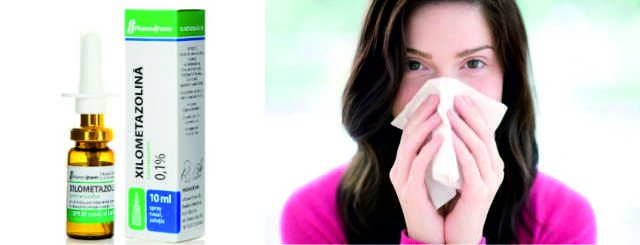
Important: vasoconstrictor drops can only be used for a strictly defined time. Otherwise, the risk of relapse of allergic edema in age is severalfold.
Antihistamines
Nasal congestion is the main symptom of allergies, which can be quickly relieved by treatment with antihistamines. Since histamine is the cause of allergies, it is the drugs of this group that relieve swelling of the mucous membrane and make breathing easier.

Antihistamines are most often sold in tablet form. The most popular of them are: Suprastin, Cetrin, Zodak, Claritin.
Hormones

Hormonal drugs are used only in cases where it is impossible to quickly relieve allergic swelling of the nose in any other way. Most often, the doctor prescribes: Nazarel, Nasonex, Flixonase.
Immunotherapy
This is a special technique that allows you to reduce nasal swelling from allergies by introducing minimal doses of the allergen. The procedure is carried out under the supervision of a doctor. Immunotherapy is a set of procedures during which the dose of an irritant substance is gradually increased. The body gets used to the stimulus and responds less and less to it. At the same time, nasal swelling from allergies decreases.
Diet
Following a certain diet will quickly help eliminate allergic swelling of the nose. You can reduce the level of creatine in the blood and reduce swelling of the nasal mucosa by eliminating the following foods from the menu:
- smoked meat;
- spicy, pungent foods;
- sausage and frankfurters;
- some types of wines.
Nasal congestion due to allergies: treatment in children
The child’s body is extremely fragile because it is in the stage of development and formation. If you are looking for a way to relieve nasal congestion due to allergies in your child, turn to natural remedies. The Aqualor Baby product line includes drops, spray and nasal aspirator. All these remedies can be used from the first days of a child’s life. Aqualor Baby contains only sea water, which includes ions of calcium, magnesium, iodine, selenium and others.
Therefore, if a child has allergies, a stuffy nose, and you don’t know what to do, then start by moisturizing the mucous membrane and rinsing the nose. Aqualor Baby contains a special nozzle that provides delicate irrigation of the mucous membrane and rinsing of the nasal cavity. The restrictive ring of the nozzle will protect against injury to the delicate baby mucosa.
Should you go to the doctor?
If you suspect an allergy, then you should go to the doctor to get tested and determine what exactly the allergen is. Neglected cases, when seasonal allergies turn into year-round rhinitis, create fertile ground for the emergence of new dangerous diseases or complications. By knowing what triggers your body's allergic reaction, you can limit your exposure to allergens. Only a doctor can prescribe prescription medication for you if needed.
How do you know that an allergy is behind this symptom?
To confirm the presence of allergies in a patient, it is necessary to inject him with provoking allergens, and if redness and a small papule appear at the injection sites, then this provoking allergen is the direct causative agent of the allergic reaction.
This method is strictly contraindicated:
- in all trimesters of pregnancy and breastfeeding;
- during the period of exacerbation of the disease;
- in childhood (up to 4 years), adults (after 50 years).
A blood test (as in a skin test) is examined by a specific list of allergen substances included in the test kits. First, common possible pathogens (allergens) are identified, and then the blood is tested for specific substances that cause an allergic reaction.
If your nose is stuffy due to allergies, it is dangerous to deal with it without prescription and consultation with a doctor. Therefore, to establish an accurate diagnosis, a visit to the doctor is necessary. This must be done immediately without wasting time.
Causes
Sneezing, itchy nose, and non-stop mucus production are signs of allergic rhinitis. It can be caused by various household and chemical allergens:
All this is in the air that a person breathes, therefore, they enter the body when inhaling air. Allergy-provoking components settle on the nasal mucosa, causing swelling.
Without proper timely treatment of nasal congestion, the disease can become chronic; swelling affects the nasopharynx and can involve the ears and eyes in the disease process, which will entail the allergic nature of the disease (hearing impairment, allergic conjunctivitis). Treatment for this disease is a complex procedure, since there are significant differences with the treatment of a common runny nose.
Treatment options
The main and only reliable way to cure an allergic runny nose is to avoid contact with the allergen. However, this, unfortunately, is not always possible.
If an allergen gets into the nasal mucosa, it is recommended to immediately rinse the nasal passages to remove the substance that causes the allergy. To do this, use special products or clean, non-chlorinated water with the addition of a few salt crystals. The following eliminators can be purchased at the pharmacy:
With timely rinsing of the mucous membrane, signs of allergy may not appear at all.
Some vasoconstrictor drugs are used locally in the form of sprays or drops, but it should be remembered that all these substances only temporarily alleviate the patient’s condition, relieving swelling of the nasopharynx, and do not eliminate the cause. In addition, frequent use of vasoconstrictor drugs like galazolin, naphthyzine is addictive, dries out the mucous membrane and causes side effects. A patient who is accustomed to the constant use of drops has a stuffy nose almost constantly, the mucous membrane is dry, and nosebleeds often occur.
If signs of allergic rhinitis appear, it is recommended to start taking antihistamines. The most commonly used drugs are loratadine and cetrizine. The dosage is selected by the doctor individually. A nasal spray containing sodium cromoglycate may be used to prevent recurrent attacks if the allergy can be classified as mild or moderate in severity.
In more severe forms, nasal glucocorticoids are prescribed.
Specific immunotherapy
If the allergen is reliably identified, it is advisable to carry out a course of treatment - specific immunotherapy with allergens. The essence of this method is to gradually “accustom” the body to the allergen. Therapy is carried out during a period of stable remission, and requires patience and consistency, since one course cannot be done. Most often, treatment requires repeating courses over 2-4 years.
How to treat?
Nasal congestion due to allergies causes severe discomfort to a person. To get rid of this unpleasant feeling, you need to use complex treatment. At the very beginning of treatment, to remove mucus that interferes with the patient’s breathing, the nose must be rinsed with pharmaceutical salt solutions (“Aquamaris”, “Dolphin”). If these are not available, you can use regular (non-chlorinated) water with added salt. Vasoconstrictors and antihistamines (Otrivin, Rinazolin, Nasonex) will help relieve swelling. Only a qualified specialist can prescribe antiallergic treatment, since the symptoms are similar to the course of a respiratory infection, for which other treatment is prescribed. In addition to sprays and drops, treatment includes tablet preparations: “Cetrin”, “Dibazol”, “Suprastin”, “Erius”, etc.
When the nose is stuffy due to allergies, treatment should not be delayed for a long time, so as not to cause addiction to the prescribed medications. Otherwise, the patient will not be able to do without drops. When the nose is stuffy due to allergies, there is a danger of provoking Quincke's edema, which in turn poses a threat to the patient's life.
Other means of combating runny nose in adults and children
In addition to prescribing medications, you can fight congestion in other ways. Below are the most effective techniques.
Massage and acupuncture of the nose are performed by influencing special biological points. The main advantage of massage is its accessibility. You can massage the base and wings of the nose, the points between the eyebrows and on the bridge of the nose anywhere and at any time.
The main feature of this treatment area is safety. There are many homeopathic remedies that can help get rid of congestion. These include:
- Aconite;
- Gelsenium;
- Allium flail;
- Stikta;
- Sulfur, etc.
Each remedy combats a specific type of problem.
Most often, folk methods act as a complement to traditional treatment. In this case, you can use the following techniques:
- rinsing the nose with saline solution;
- instillation of aloe juice and garlic into the nose;
- carrying out steam inhalations over decoctions of chamomile, calendula or regular potatoes.
Herbal medicines are distinguished by their safety, due to which they can be used both in pregnant and lactating women, and in children. The best means are:
- chamomile;
- sage;
- calendula;
- eucalyptus leaves.
Surgical treatment of difficult nasal breathing is performed only in emergency cases. Such situations include:
- adenoids;
- deviated septum;
- tumor processes;
- the presence of severe inflammation;
- entry of a foreign body.
Physiotherapy for nasal congestion includes several techniques:
- UFO (ultraviolet radiation) - this procedure is carried out 2-3 days in the morning. Each nasal canal is treated for 1-2 minutes, depending on the complexity of the disease;
- UHF - treatment is carried out through weak electrical impulses. At the same time, it is recommended to carry out the procedure in the same way in the morning;
- Laser therapy is carried out in a physiotherapy room under the supervision of a specialist. It is considered the most effective.
There are several points responsible for the feeling of nasal congestion. In this case, acupuncture gives an amazing effect, almost instantly making a person’s breathing easier. It is important to understand that only an experienced specialist should perform the procedure.
To treat your nose at home, you can use the following tips:
- wash the mucous membrane daily - to prepare the solution, you need to take 0.5 teaspoon of sea salt and dissolve it in a glass of warm water. After this, the mixture is drawn into a syringe and injected into one nostril, while holding your breath. After this, the procedure is repeated from the second nostril;
- Instill fresh aloe juice into your nose, 2-3 drops in each nostril in the morning and evening.

